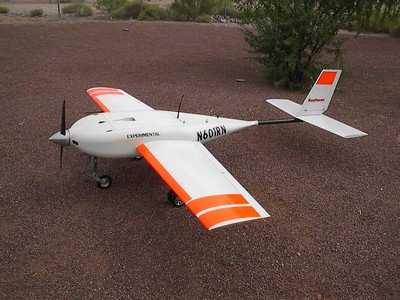Sat, Nov 04, 2006
Tiny Aircraft To Help Company Develop Unmanned Systems
 Raytheon received an Experimental
Airworthiness Certificate (EAC) for its Cobra Unmanned Aircraft
System (UAS). This is the third unmanned aircraft and the first of
its size certified by the FAA.
Raytheon received an Experimental
Airworthiness Certificate (EAC) for its Cobra Unmanned Aircraft
System (UAS). This is the third unmanned aircraft and the first of
its size certified by the FAA.
Raytheon says the Cobra is a low-cost, highly reliable UAS
designed to support the development, integration and test of its
unmanned systems technologies. The aircraft has a wingspan of 10
feet and is 9-feet long -- no wonder it's unmanned!

Restrictions to the Cobra's EAC permit flight operations only in
a specified section of Southeastern Arizona. The EAC authorizes
Raytheon to conduct research and development, crew training and
market surveys using the Cobra UAS.
In furthering the development of Raytheon's unmanned systems, it
will use the Cobra test bed to test and demonstrate sensor systems;
networked command, control and communications systems; and UAS
architectural concepts.
Raytheon's vice president of Missile Systems Ken Pederson said,
"The Cobra UAS will significantly decrease costs and compress
schedules for bringing new UAS technologies to market. Our
customers will benefit from our ability to support both internal
Raytheon development efforts and their programs with Cobra, without
increasing the pressure on tactical systems and valuable range
resources."
Raytheon worked closely with the FAA to receive the Experimental
Aircraft Certification, providing Cobra UAS design, manufacturing,
maintenance, safety, operations and training documentation for its
review and approval. The final step in the certification process
was a demonstration of Cobra UAS ground operations conducted under
the observation of FAA teams from Washington and Phoenix.
The Cobra UAS is composed of the aircraft and ground elements.
The ground element consists of two control systems -- the Cloud Cap
Technology Piccolo Ground Control Station and the Raytheon IIS
next-generation Multi-Vehicle Control System (MVCS). The MVCS uses
the NATO Standardization Agreement (STANAG) 4586 interface to
communicate with the Cobra aircraft. The dual control system
configuration provides for maximum flexibility and safety during
testing.
More News
Aero Linx: Model Aeronautical Association of Australia MAAA clubs are about fun flying, camaraderie and community. For over 75 years, the MAAA has been Australia’s largest fl>[...]
Touchdown Zone Lighting Two rows of transverse light bars located symmetrically about the runway centerline normally at 100 foot intervals. The basic system extends 3,000 feet alon>[...]
“Discovery and innovation are central to our mission at Virgin Galactic. We’re excited to build on our successful record of facilitating scientific experiments in subor>[...]
How To Get A Story On Aero-TV News/Feature Programming How do I submit a story idea or lead to Aero-TV? If you would like to submit a story idea or lead, please contact Jim Campbel>[...]
Student Pilot Reported That During Rotation, “All Of A Sudden The Back Of The Plane Kicked To The Right..." Analysis: The student pilot reported that during rotation, “>[...]
 ANN's Daily Aero-Linx (05.02.24)
ANN's Daily Aero-Linx (05.02.24) ANN's Daily Aero-Term (05.02.24): Touchdown Zone Lighting
ANN's Daily Aero-Term (05.02.24): Touchdown Zone Lighting Aero-News: Quote of the Day (05.02.24)
Aero-News: Quote of the Day (05.02.24) ANN FAQ: Contributing To Aero-TV
ANN FAQ: Contributing To Aero-TV NTSB Final Report: Cirrus Design Corp SR20
NTSB Final Report: Cirrus Design Corp SR20




